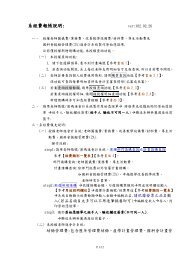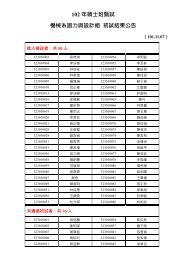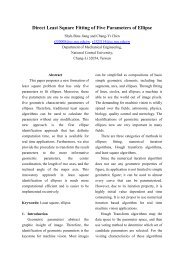An automatic fire searching and suppression system for large spaces
An automatic fire searching and suppression system for large spaces
An automatic fire searching and suppression system for large spaces
Create successful ePaper yourself
Turn your PDF publications into a flip-book with our unique Google optimized e-Paper software.
ARTICLE IN PRESS<br />
302<br />
T. Chen et al. / Fire Safety Journal 39 (2004) 297–307<br />
Y ¼ Y 2 cos o 2 Z 2 sin o 2 þ D sin o 2 ;<br />
Z ¼ Y 2 sin o 2 þ Z 2 cos o 2 þ D cos o 2 :<br />
ð4Þ<br />
Take Eq. (2) into (3) <strong>and</strong> eliminate Y 1 , the relationshipbetween Y <strong>and</strong> Z has an<br />
expression<br />
Y ¼ ðy 1 cos o 1 f sin o 1 ÞðZ D cos o 1 Þ<br />
þ D sin o 1 : ð5Þ<br />
y 1 sin o 1 þ f cos o 1<br />
Take Eq. (2) into (4) <strong>and</strong> eliminate Y 2 , the relation between Y <strong>and</strong> Z has another<br />
expression<br />
Z ¼ ðy 2 sin o 2 þ f cos o 2 ÞðY D sin o 2 Þ<br />
þ D cos o 2 : ð6Þ<br />
y 2 cos o 2 f sin o 2<br />
Solution of Y <strong>and</strong> Z can be obtained from Eqs. (5) <strong>and</strong> (6), as shown in Eq. (7).<br />
Y ¼ Dðy 2 f tan o 2 Þ½ðsin o 2 sin o 1 þ A cos o 1 B cos o 2 Þ=ðA þ BÞ D cos o 2 Š<br />
y 2 tan o 2 þ f<br />
þ D sin o 2 ;<br />
Z ¼<br />
D<br />
A B ðsin o 2 sin o 1 þ A cos o 1 B cos o 2 Þ; ð7Þ<br />
where<br />
A ¼ðy 1 f tan o 1 Þ=ðy 1 tan o 1 þ f Þ;<br />
B ¼ðy 2 f tan o 2 Þ=ðy 2 tan o 2 þ f Þ: ð8Þ<br />
In the above equations, y 1 <strong>and</strong> y 2 are still unknown. Actually, they can be<br />
calculated from the pixel coordinates (i, j) of the images, because most of the CCD<br />
camera are of the same st<strong>and</strong>ard specifications. Suppose the CCD camera’s scanning<br />
area is known as H V pixels <strong>and</strong> h v m 2 , the relationshipbetween [y 1 , y 2 ] <strong>and</strong><br />
[j 1 , j 2 ] can be found.<br />
y 1 ¼ðj 1 V=2Þv=V;<br />
y 2 ¼ðj 2 V=2Þv=V: ð9Þ<br />
Thus the <strong>fire</strong> position P(d,a) in the space is confirmed <strong>and</strong> expressed as<br />
pffiffiffiffiffiffiffiffiffiffiffiffiffiffiffiffiffi<br />
d ¼ Z 2 þ Y 2 ; ð10Þ<br />
a ¼ tan 1 ðY=ZÞ:<br />
ð11Þ<br />
2.3. Working process<br />
Initially, the <strong>fire</strong> monitor is set at the horizontal-left limit position. Once a <strong>fire</strong> is<br />
detected by a <strong>fire</strong> detector in the <strong>system</strong>, the corresponding <strong>fire</strong> monitor will be<br />
activated. It will start <strong>searching</strong> <strong>for</strong> <strong>fire</strong> <strong>and</strong> be driven to the down-right limit<br />
position step-by-step (shown in Fig. 3). The <strong>fire</strong> monitor rests <strong>for</strong> a short time after<br />
each step. During this period of time, continuous images are captured from the CCD

















